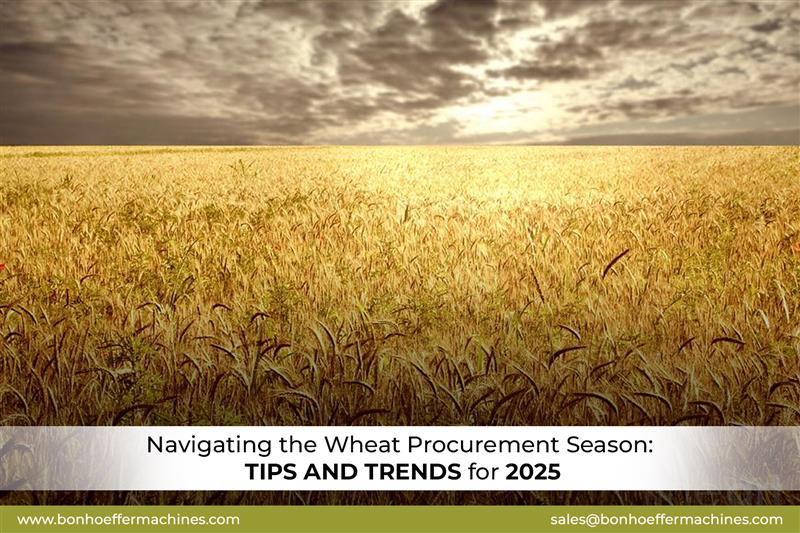
The wheat procurement season is a critical period for Indian farmers. Selling at the right time and place can significantly impact profits. With evolving government policies, market fluctuations, and the rise of digital selling platforms, farmers need to stay informed to maximize their returns.
This guide provides practical insights into market trends, government support, procurement strategies, and digital platforms that can help farmers navigate the 2025 wheat procurement season effectively.
1. Understanding Market Trends and Expected Prices for 2025
Wheat prices depend on several factors, including:
- Government Minimum Support Price (MSP)
- Private demand from flour mills, exporters, and wholesalers
- International supply trends and climate conditions
Government MSP for 2025
The government revises the MSP annually to ensure fair pricing for farmers. In 2024, the MSP was ₹2,125 per quintal, and early estimates suggest it may increase to ₹2,200-2,250 per quintal for 2025. Farmers should monitor official announcements for confirmation.
Key takeaway: Track government updates and market trends through platforms like Agmarknet, eNAM, and FCI to make informed decisions.
2. Selling Through Government Procurement Centers
The government procures wheat at MSP through mandis and procurement centers operated by:
- Food Corporation of India (FCI)
- State government agencies
New Changes in 2025
- Mandatory online registration for government procurement in many states
- Digital payment system ensuring direct bank transfers within days
- Mobile apps for tracking procurement status in some states
Steps for Selling Wheat to the Government
- Register in advance at procurement centers
- Ensure bank account details and Aadhaar linkage are updated
- Stay informed about state-wise procurement schedules
Late registration can result in missing the procurement quota, so timely action is crucial.
3. Private Buyers vs. Government MSP: Making the Right Choice
Farmers have multiple options for selling wheat beyond MSP procurement, including:
- Private traders
- Flour mills and food processing companies
- Exporters and wholesalers
Which Option is Better?
- If private buyers offer higher prices than MSP, consider selling directly to them.
- If the government MSP is the best available price, sell through FCI and state procurement centers.
- Platforms like eNAM (Electronic National Agriculture Market) allow farmers to compare mandi rates in real-time before making a decision.
Finding Private Buyers
- Contact local agri-traders and flour mill owners
- Use digital platforms like eNAM, AgriBazaar, and KisanMandi
Monitoring daily mandi rates ensures farmers sell when prices are at their peak.
4. The Role of Digital Platforms and e-Mandis in 2025
Technology is transforming the agricultural supply chain, making wheat selling more efficient. Some of the major digital platforms playing a role this year include:
eNAM (Electronic National Agriculture Market)
- Enables farmers to compare mandi prices nationwide
- Expands selling opportunities beyond local markets
State-Specific e-Mandis
- States like Punjab, Haryana, and Madhya Pradesh have their own digital procurement platforms
- Farmers can register online, reducing the time spent waiting at mandis
Direct Selling to Flour Mills and Exporters via Apps
- Platforms such as AgriBazaar and KisanMandi enable direct transactions with bulk buyers
How to Get Started?
- Register on eNAM, AgriBazaar, or the state’s e-mandi portal
- Upload wheat details including quality, quantity, and location
- Compare offers from buyers across the country
Farmers should explore these platforms as they often provide better prices than local mandis.
5. Strategies to Get the Best Price for Wheat in 2025
Maximizing wheat profits requires careful planning. Here are five strategies to ensure a good return:
- Monitor market trends – Compare prices across different mandis and platforms before selling.
- Ensure proper wheat quality – Clean, uniform, and well-dried wheat fetches better prices.
- Consider storage options – If prices are low during harvest, storing wheat for a few months can lead to higher profits later.
- Register early for procurement – Government buying operates on a first-come, first-served basis.
- Utilize digital platforms – eNAM and AgriBazaar can help identify competitive prices.
Investing in high-quality farming equipment for harvesting and post-harvest processing can also reduce wastage and improve profitability.
Need Expert Guidance? Connect with Bonhoeffer Machines
At Bonhoeffer Machines, we are committed to helping farmers optimize their agricultural operations. If you have questions about wheat procurement, feel free to reach out:
Our team is available to provide guidance, and we are always open to discussing topics that matter most to farmers.
Explore High-Quality Agricultural Machinery
Bonhoeffer Machines offers a range of agricultural equipment to support wheat farming, including:
- Power Tillers and implements
- Sprayers
- Irrigation pumps
- Solar Products
For more details, visit Bonhoeffer Machines’ product catalog and explore machinery designed to enhance farm productivity.
Final Thoughts: Selling Wheat Smartly in 2025
The 2025 wheat procurement season presents opportunities for farmers to maximize profits through strategic selling. Key takeaways include:
- Staying informed about MSP updates and private buyer rates
- Registering early for government procurement
- Leveraging e-mandis and digital platforms for better price discovery
- Maintaining high wheat quality to secure premium pricing
By adopting these strategies, farmers can navigate the season effectively and achieve better financial outcomes.







